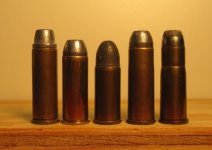Howdy
There is no question of what model you own. S&W only made one large frame top break double action revolver. Generically they were all called the 44 Double Action. They are very distinctive looking, with the vertical cut on the cylinder and the very distinctive trigger and trigger guard. They were only made from 1881 until 1913, although all of the frames had actually been manufactured by 1899. They also came in a target version with target sights, but yours has the standard fixed sights.
As has been stated, most of these guns came chambered for 44 Russian, which is an earlier cartridge than 44 Special. 44 Russian is about 1/10" shorter than 44 Special.
There were some made in 44 WCF and 38 WCF. These were given special names, the 44 WCF version was called the 44 Double Action Frontier, and the 38 WCF version was called the 38 Winchester Double Action. There was also a very rare version called the 44 Double Action Wesson Favorite, but that is not what you have. The Favorite was a lighter weight version with metal removed in some areas of the gun.
You have already stated that your revolver is 44 caliber. That narrows it down to either the standard 44DA, or the 44 Double Action Frontier. If you measure the length of your cylinder it will either be 1 7/16" long or 1 9/16" long. The longer cylinder will mean it is the 44 Double Action Frontier, the shorter cylinder, for the early Serial Number you have, will mean it is the standard 44 Double Action, chambedred for 44 Russian. That's really all there is to it. By the way, these guns were never chambered for 44 Special.
I have attached a photo of a few cartridges so you can see their relative lengths, and why the 44 WCF and 38 WCF guns needed the longer cylinders. Left to right in the photo the cartridges are 44 Magnum, 44 Special, 44 Russian, 44-40 (44WCF), and 38-40 (38WCF). You can see how much shorter the 44 Russian cartridge is. 44 Russian was the cartridge S&W developed for the Russian government when they won a large order to supply the Czarist government with revolvers. It became the most popular 44 cartridge S&W chambered their revolvers for until they developed the 44 Special about 1907. The 44 Special was developed from the 44 Russian. It shares all the same dimensions except it is about 1/10" longer. The 44 Special was developed for S&W's first 44 caliber revolver with a swing out cylinder, popularly known as the Triple Lock.
P.S. I see you are anxious to shoot it. Let me warn you again, do not shoot modern Smokeless ammunition in it. This includes Cowboy ammunition. If you send the gun to Dave Chicoine he will back me up in that statement. Your gun should only be fired with ammunition loaded with Black Powder.




